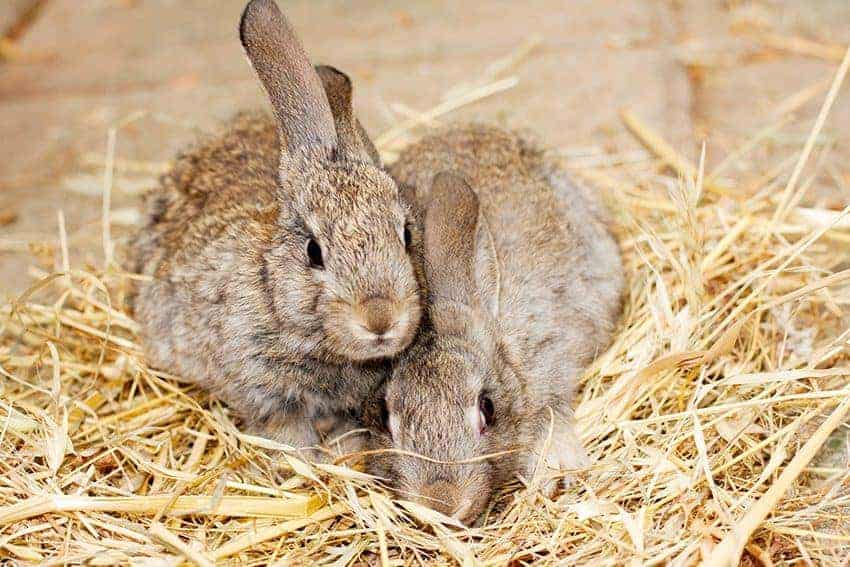
Once upon a time, bunnies were seen as simple pets to look after, ideal for children, who’d be happy in a hutch with a carrot for company. Thankfully, today we’re much more aware of the complex needs of these intelligent and curious animals.
Start with the essentials
Pet rabbits need a large shelter that’s dry, draught-free, well ventilated and protected from predators and extremes of weather and temperature, with a spacious, secure exercise area permanently attached to it.
They also need lots of good quality feeding hay to keep their digestion healthy and help wear down their continually growing teeth. Feeding some hay from a hay rack or hanging basket keeps it clean and above floor level.
Bunnies also enjoy a daily portion of high quality rabbit nuggets and a handful of leafy greens such as kale and mint. Ensure they also have constant access to fresh drinking water.
Never keep a rabbit on its own. Rabbits are highly social creatures who like to play and groom together and should be kept with at least one other friendly, neutered rabbit. Never keep rabbits with guinea pigs as they have very different needs. Rabbits can also carry diseases which can be very harmful to guinea pigs
Add enrichment
Enrichment is all about making an animal’s life more fulfilling. Enrichment aims to provide opportunities for animals to demonstrate natural behaviours, provide mental stimulation and different experiences for their senses, and give them opportunities for exercise. Without sensory stimulation and engaging activities, pet animals such as rabbits can become bored and may develop negative behaviours that are detrimental to their health and wellbeing. Here are three things you can do to give your bunnies a boost:
1. Hiding places are very important to rabbits
As a prey species, they must have constant access to safe hiding places where they can escape if they feel afraid. These should be provided in addition to rabbits’ main shelter and positioned in quiet areas free from the sights and smells of potential predators, away from draughts and out of direct sunlight. Wooden houses, in the style of a small kennel, can make excellent hides – search for ‘hop in hideouts’ and ‘hideaway boxes’ – but make sure they are big enough for your rabbits to be able to stretch out comfortably.
An alternative to a specifically designed rabbit box shelter is a small hutch. Two to three foot hutches are much too small to use as living spaces, but they are easy to pick up second hand and, with the doors removed, make excellent bolt holes. To ensure hiding places are effective and feel safe, never trap or remove your rabbits from them.
Rabbits also benefit from having platforms, from which they can scan their surroundings for danger. Platforms are also useful in building physical fitness and bone strength, as jumping on and off them is an important weight-bearing exercise. You can create platforms from straw bales, wooden crates or tree stumps (from fruit trees not treated with chemicals).
2. Many rabbits like to dig
This isn’t really surprising as our pet bunnies are related to the wild European rabbit, whose scientific name is Oryctolagus cuniculus, which means ‘hare-like digger of underground passages’. The biology and behaviour of pet rabbits is very similar to that of their wild relatives, so it will be highly beneficial to provide them with some form of ‘digging box’.
A large plant pot or litter tray filled with earth, or a sandpit filled with child-friendly sand, provides a safe place for them to have fun and get some extra exercise. Just watch that earth fly as those powerful bunny digging legs go into action!
3. Toys can provide hours of entertainment for curious and intelligent rabbits
From specially-designed activity tunnels to run through and low wicker fences to hop over, to cardboard boxes with holes cut into them for them to explore. Cardboard tubes can be stuffed with feeding hay as part of their daily ration, and you can also try untreated straw or wicker baskets and balls and gnaw sticks .
Different rabbits enjoy different types of toys, so provide a variety of items until you find out which ones your rabbits like best. Always keep a look out for something new for them to explore and make their mark on.
Rabbits use scent that’s not detectable by humans as an important means of communication, so providing objects within your rabbits’ home where they can scent mark using chin secretions, urine and droppings, will make their environment smell familiar and reassuring.
Find out more about how to have happy bunnies
Children and rabbits: Traditionally thought of as good pets for children, rabbits are not easy to look after correctly. Small animals are often more complex to feed and care for than a cat or dog, and require more looking after than a child can offer. So, while it’s lovely for children to enjoy the company of rabbits, the responsibility for any animal’s wellbeing lies with adults, who must always be responsible for overseeing their care.
Sources: rspca.org.uk, pets4homes.co.uk














